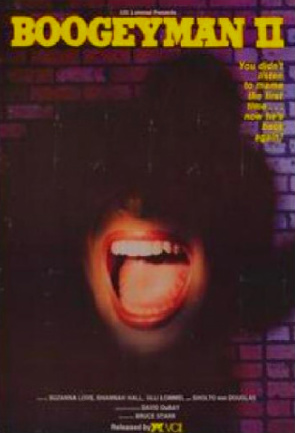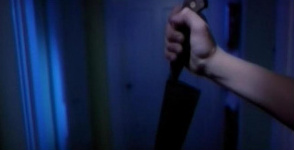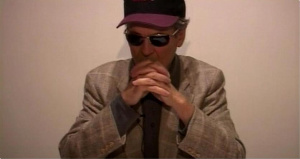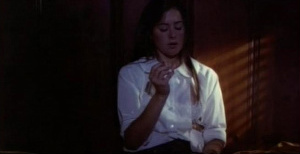
Sequels by their very nature are comprised of recycled elements of a previous success, but there have been occasions when they have surpassed fan’s expectations by matching the original in both style and popularity (Aliens, The Godfather: Part II, Terminator 2: Judgement Day). Then there are others which simply follow in the footsteps of their predecessors and plagiarise their earlier instalments. The slasher film, perhaps more than any other genre, can be accused of reusing the same gimmicks time and time again as studios produce one pointless sequel after another, but even with such neverending franchises as Friday the 13th and Halloween each movie offered something new. When The Boogeyman allegedly made $25m at the box office in the winter of 1980, it was inevitable that its director, Ulli Lommel, would eventually decide to make a follow up, but few could have guessed the route which he would decide to take.
Lommel was born in Germany towards the Second World War and was first introduced to drama at the age of four when his father, noted comedian Ludwig Manfred Lommel, decided to include him in his act when he was only four years old. Developing a taste for acting, Lommel enjoyed a successful collaboration with filmmaker Rainer Werner Fassbinder as well as a career that flirted between theatre and screen. After directing his first feature, Haytabo, in 1971, Lommel worked on several low key projects before deciding to relocate to New York in 1978 where he made the acquaintance of artist and exploitation producer Andy Warhol. The following year he would meet actress Suzanne Love during the filming of Cocaine Cowboys and the two would soon marry. Deciding to develop a project together, Lommel and Love co-scripted The Boogeyman, a low budget horror that would borrow heavily from John Carpenter’s 1978 blockbuster Halloween, as well as various urban legends. After giving his wife the starring role in his crime thriller Olivia, Lommel soon came to the conclusion that it was time to make a sequel to his horror, something which had become a surefire way to make a quick profit.

Boogeyman 2 opens with a brief montage from the first movie, with a child’s hand brandishing a knife as it heads down a corridor towards a closed door. Inside the room, a couple make out on the bed as two young children slowly open the door and the boy, Willy (Jay Wright), sneaks across the floor to where they are are repeatedly stabs them both to death whilst his sister, Lacey (Natasha Schiano), watches in terror. The film then cuts to an interrogation room where Mickey Lombard (Lommel) is being charged with murder. An unseen police officer reads him his Miranda rights before he wavers the need for an attorney to be present. He then states that the events took place twenty two years earlier, although due to his memory deteriorating over time he can only remember certain elements of what happened. There is then a fast montage of the murder of a young couple before Lombard recalls a woman who once told him the story of a series of killings which once took place which ‘she blamed on the boogeyman.’ Stating that this all began when the woman was five years old, the film then cuts back to the opening murder, in which Willy slaughters his mother and her lover.
As the woman had told Lombard about the various murders that had later occurred his wife, Bonny (Shannah Hall), decides that this would make an interesting basis for a horror movie, despite him only being a documentary filmmaker. But realises that they need a financial success, he eventually agrees and sets out to adapt the events into a feature film. These recollections are interspersed with extensive sequences from The Boogeyman, in which the two children have now grown up and Lacey (Love) lives with her husband and Willy (played by her real life brother, Nicholas Love), who has not uttered a word since the incident. Lacey herself suffers from hallucinations and is plagued by her childhood trauma, with even the sight of a carving knife causing that night to come flooding back to her. Lombard then explains how his wife acted as producer for his adaptation, entitled The Boogeyman, and how during pre-production a mysterious butler had appeared at his door to offer his services and how Lombard believed that he had been the one who had committed all of the murders that he had been arrested for as he disappeared soon afterwards.

Still haunted by her visions and seemingly possessed, Lacey decides to face her past by visiting the house where the events had occurred. After seeing images of her mother’s lover in a mirror, she accidentally breaks the glass which inadvertently releases his vengeful spirit. Her husband, Jake (Ron James), brings the mirror home with them and glues the pieces back together, forcing Lacey to deal with her past once and for all. Lombard states that during the making of the film there were various mysterious events, such as his wife’s car exploding, which had convinced them that the production was cursed. He still denies that he had anything to do with the series of murders that took place over two decades earlier and states that he had no interest in making the movie to begin with. He then claims that he the boogeyman really committed the crimes and that he has nothing to fear when standing trial.
The viewer can watch Boogeyman 2 in one of two ways, depending on how tolerant they are of repetition and experimental filmmaking. This movie could perhaps be interpreted as a satire on the film industry, with a documentarian’s attempts to produce a commercial feature being revealed in flashbacks as he describes the bizarre events that had dogged every stage of production, in much the same way the makers of The Exorcist, The Omen and Poltergeist had also claimed. Eager to capitalise on a series of true events which had torn a family apart and had resulted in a series of brutal murders, the director had decided to move into mainstream filmmaking by adapting the incident into a generic horror film for mass consumption. Even during his interrogation, Lombard seems more interested in reminiscing about the making of his movie than the actual murders which he had been accused of.
The other way to view Boogeyman 2 is as the most pointless movie ever made. Lommel would return to the movie two decades later to add many additional sequences in order to extend his original concept for the director’s cut (released on DVD as Boogeyman 2 Redux), taking the central role himself whilst allowing Bruce Starr to co-write a few new scenes which he would shoot cheaply in one room, with additional footage which would occasionally appear throughout the film. The concept of a film being based on the original murders which is then plagued by the boogeyman is an interesting idea and one which Lommel should have taken more time over developing, but his decision to simply recycle most of the footage from the first movie shows a lack of inspiration on his part. Fans only need to see either The Boogeyman or Boogeyman 2, but there is no real need to watch both.


6 Responses to Boogeyman 2 (1983) Review